The shape of things to come: Work in 2022
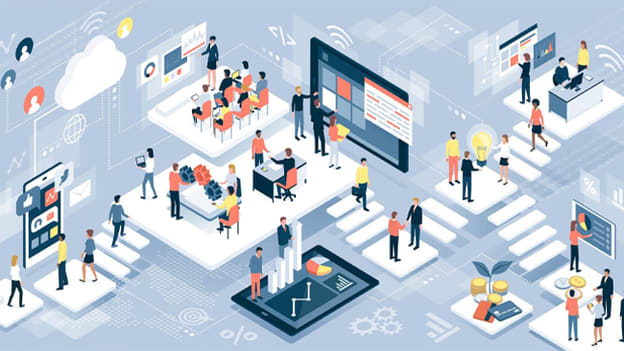
We are entering 2022 with a fundamentally transformed view of work. While risk from variants will persist for some time, organisations are realizing they will be at greater risk if they do not seize the moment for the long term taking into consideration the broader drivers of value including talent management, customer acquisition, productivity, and revenue.
How will employee experience shape up in 2022? How will HR’s influence shape out in the third year of the pandemic? What are some of the changes organisations will bring forth to seize the moment for the long term?
We spoke to HR leaders to understand how the new age of work will look like in 2022. Here’s what they had to say.
Pandemic has provided a framework that the world will follow
Employee experience being key in driving business outcomes for an organization was never in debate. However, what the pandemic has done is provided a framework that the world will follow for a foreseeable period of time to come, shared Preeti Kaul, People and Culture Head, upGrad. This “the new normal” will revolve around empathy, flexibility, personalisation and empowerment.
In this interconnected global world, the employees around the world are keeping a close watch on how the leaders are reacting to the new reality. So, in order to be competitive enough in the war of talent, the leaders need to ensure that they build a people-first culture, where physical, mental, and financial well-being has the foremost importance.
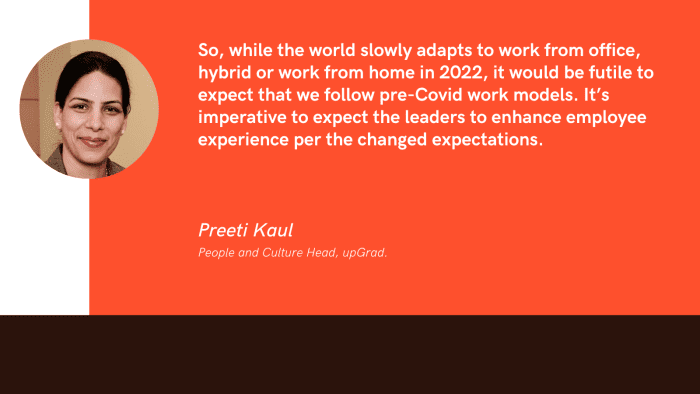
The same views are averred by Ben Eubanks, Chief Research Officer, Lighthouse Research & Advisory who shared that we will see companies really leaning into how they treat and support their people.
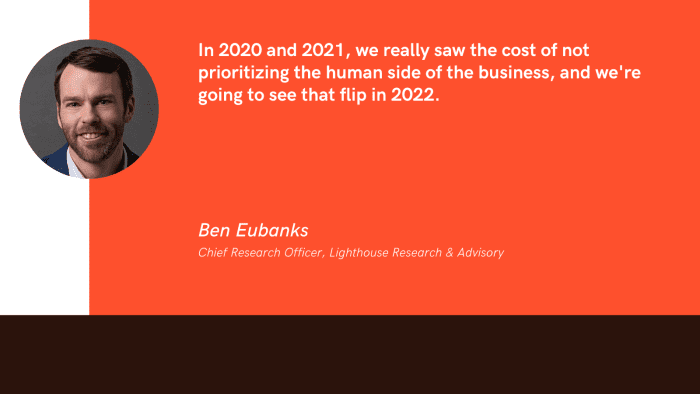
Sunit Sinha, Partner and Head, People, Performance and Culture, KPMG in India added that the COVID-19 pandemic only accelerated a trend of more enhanced and end to end “experience” view of people/ HR processes and policies. The new generation of the workforce has grown up in a mobile first, high experience and sharing world driven by combination of the digital and physical.
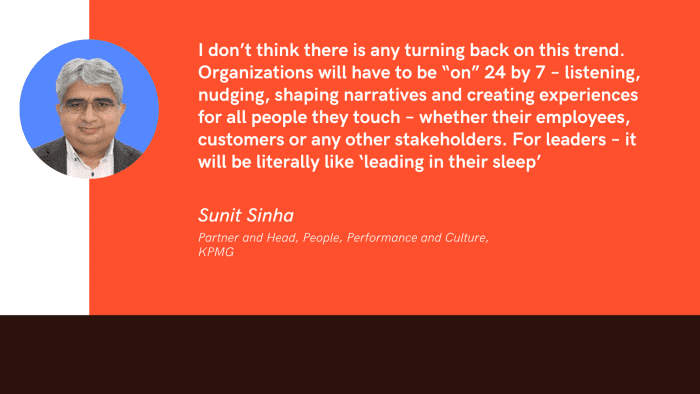
HR is at the forefront of establishing social dynamics in this new environment
The crisis as well as the post-crisis world, has definitely had an impact on HR, being instrumental in maintaining business continuity while ensuring that the people health metrics are kept intact. While at the tactical level, HR needs to manage the operations of employees working in a hybrid manner across different locations and time zones but at a strategic level too, they played a major role in re-defining the organizational culture, work practices, policies, tolls, systems to make it more people-centric focussing on health safety, resilience, agility, and adaptability.
“We are at the forefront of laying down the work principles and establishing the social dynamics in this new environment,” shared Preeti.
The humane face of the employer and the need to keep it intact during the worst of times has been reinforced, feels Vivek Kulkarni, Executive President and Head Human Resources, ENIL (Mirchi). Companies would do well to define/redefine them afresh and make it a key employer value proposition. Clearly, the 'voice of the employee' will play a large role in defining what would be the employer’s promise to its workforce.
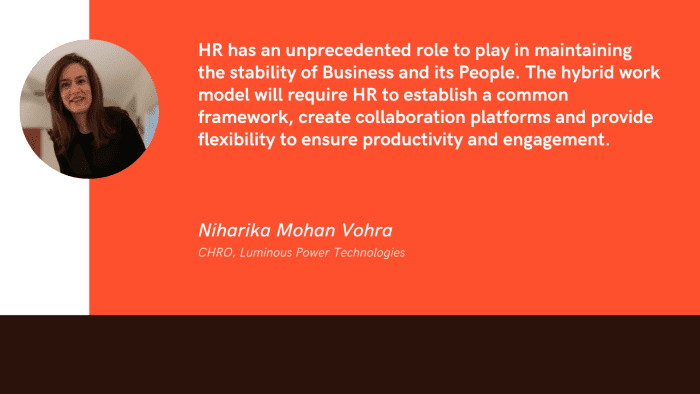
A holistic professional experience is what organisations are now aiming for
COVID or no COVID, agility and inclusivity are the pillars of long-term resilience. Work models have evolved and changed, with remote collaborations and blend of physical and virtual work eco-systems being the new norm, flexibility is here to stay. Digitization too has seen a phenomenal uptrend and organizations have invested heavily in digital tools.
However, with hybrid working and flexibility, employees are looking at personalised experiences, catering to their individual needs versus organisation wide approaches. The toll that the pandemic took on each one of us personally and professionally, holistic professional experience is what organisations are now aiming for and a lot of it is going to be aided by digital and self-service tools. Organisations that provide mental and emotional health support, to address challenges that employees face in hybrid workplaces such as increased stress and anxiety levels and set up flexible work models while keeping the social workplace fabric alive will be the winners in the long term, Preeti averred.
Ben added that employers have to embrace flexibility, and not just about remote work.
“Our brand new data from more than 1,000 workers shows that the types of flexibility they want most include autonomy in their work, more choices about benefits, and an opportunity to bring ideas for innovation purposes.”
The same was reiterated by Sunit who said that for too long our structures, processes and policies have borrowed from Frederick Taylor and the thinking of the mass production shop floor.
“In a role of design thinking and experience – we need to design for human experience and not just for operational efficiency.”
At a mindset level and this is truer for leaders – a sense of control and stability (or Business As Usual (BAU) will need to be let go – it’s going to be about being nimble and embracing a sense of impermanence. And for the employee-organization psychological contract – we are well beyond multiple jobs/ roles – very soon we will need to think in terms of the extended workforce and portfolio careers.
Networks and relationships will need to be reconstructed
Workspaces are as much a social unit as they are economic units, averred Vivek. So, while costs and productivity norms remain paramount along with people safety, leaders will also strive to make their offices thrive with the usual buzz and energy that was the lifeline of many an organisation.
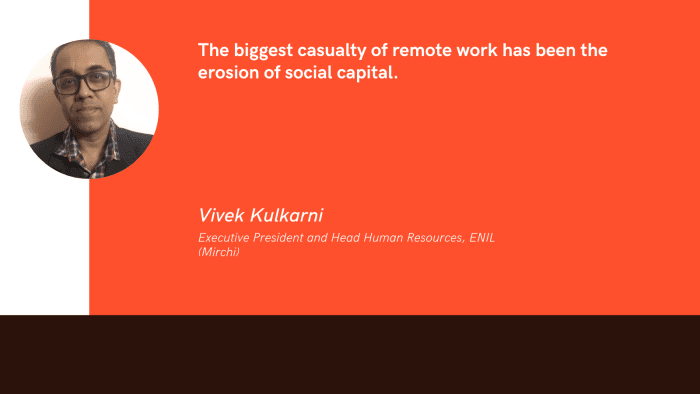
Virtual onboarding for all the sheen that you get to see on the employer’s LinkedIn page when it is flashed is no substitute for the in-person learning and onboarding that happens with colleagues around you. So, the networks and relationships will need to be reconstructed and that can happen only with a Return to Work even as it co-exists with a liberal WFH policy as well.
Niharika concluded aptly that the world has undergone drastic changes and a tremendous amount of work has gone in to adapt to the new normal by organizations and individuals. The key is not to lose the momentum gained so far and to remain open to Change and Innovation. Organization culture needs to reflect agility, resilience and humility to keep moving forward in order to rebuild and recover.













